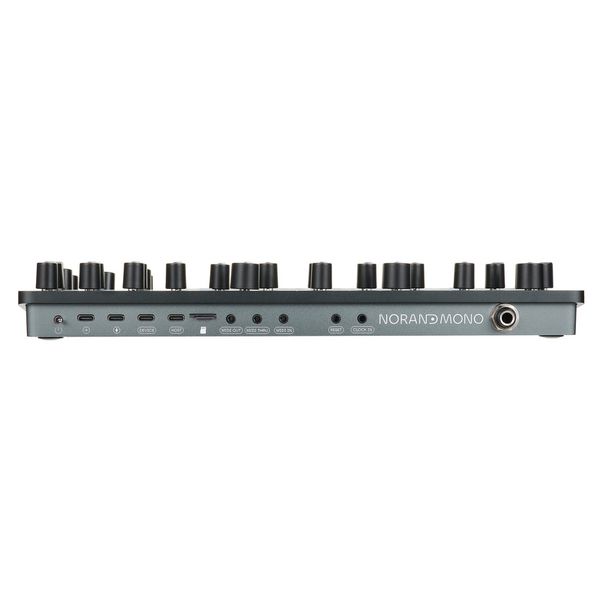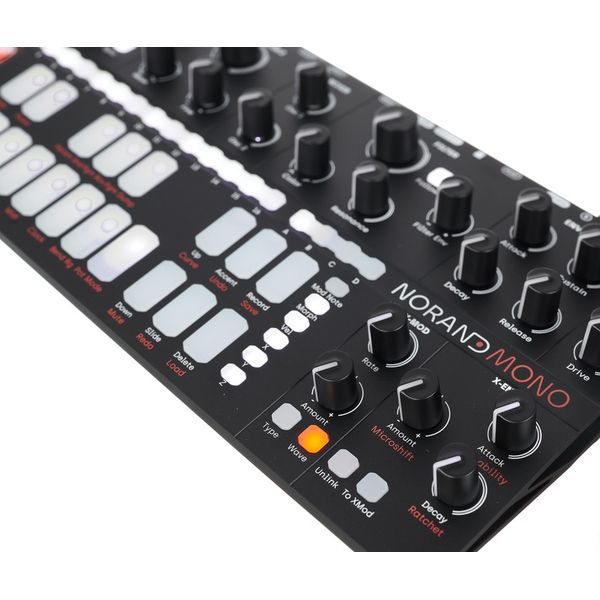Der Norand Mono mkII ist ein Analogsynthesizer mit 2 Oszillatoren – jeweils mit variabler Wellenform (von Sinus über Dreieck und Rechteck bis Sägezahn), through-zero-FM und Sync, einem 3-pol Multimode Filter (der von Tiefpass zu Bandpass oder Hochpass geblendet werden kann), sowie einem ADSR. Die absolute Besonderheit der Klangerzeugung ist, dass jeder Klangparameter mit einem eigenen LFO (X-Mod) und einer eigenen Hüllkurve (X-Env) mit Attack, Decay und bipolarem Amount moduliert werden kann. Wenn gewünscht regelt der X-Envelope auch die Intensität des X-Mod LFO. Die Bedienung ist dabei ausgesprochen elegant gelöst, da die "X-" Module immer dem zuletzt bewegten Klangparameter folgen – bis sie mittels "Unlink" Button entkoppelt werden. So kann beispielsweise der LFO für die Filterfrequenz im Zugriff bleiben während man den Regler für Resonance oder andere Klangparameter spielt (ein wichtiges Detail, das bei der älteren Version noch fehlte). Jeder X-Mod LFO kann frei oder temposynchron laufen und reicht mittels verschiedener Modi von sehr langsam bis weit in den Audio Bereich. Dabei kann er auf Wunsch auch Oszillator synchonisiert werden, wodurch auch FM-Klänge möglich werden. Zudem verfügt das kompakte Gerät über eine durchaus feinfühlig spielbare 1-Oktaven MPE-Tastatur, deren X, Y und Z Position über dedizierte Buttons beliebigen Parametern zugeweisen werden kann. Überhaupt ist es eine Wohltat, so etwas ohne Display erledigen zu können. Und natürlich kann alles auch mittels eines ausgeschlafenen 64 Step Sequencers programmiert werden, der pro Step nicht nur statische Werte, sondern auch Wertveräufe mit einer zeitlichen Auflösung von 1024 Ticks ermöglicht. Im Prinzip überigens für jeden Parameter (es gibt angeblich ein Maximum für gleichzeitig modulierbare Parameter, aber es ist in der Praxis nicht relevant). Die Menge interner Controllerdaten hätte jeden klassischen Hardwaresequencer vermutlich in die Knie gezwungen, aber das FPGA im Norand Mono mkII (auf dem die Steuerung samt der X- Module digital realisiert sind) hat damit offenbar keinerlei Probleme. Toll ist auch, dass die Potis von Parametern unter Modulations- und Sequenzerkontrolle stets spielbar bleiben, um Offsets der Parameterwerte "live" anzuwenden. Es gibt sogar Undo (und Redo) Steps – in mehr als ausreichender Anzahl. Solchen Komfort gab es bisher meines Wissens nur in Plug-ins!
Auch die üppige Ausstattung mit USB C Ports (Host, Device, Power Input und Output), einem kompletten MIDI Trio (zeitgemäß in TRS Typ A) und TS Inputs für Clock und Reset (z.B. von einem Modularsystem) wirkt sehr zeitgemäß. Die mechanische Qualität (feste Potis, Aluminiumgehäuse) macht ebenfalls einen sehr guten Eindruck. Bis auf einen integrierten "Drive" Parameter (der natürlich voll modulier- und automatisierbar ist) wird auf Effekte jeder Art verzichtet. Das geht extern ohnehin besser.
Der Norand Mono mkII demonstriert eindrucksvoll, was mit einem monophonen Analogsynthesizer unter digitaler Kontrolle heute möglich ist. Es ist vielleicht kein ideales Einsteigergerät – zumindest sollten externe Effekte (auch weitere Klangerzeuger, Mischpult) vorhanden sein. Wer aber die Geduld aufbringt, sich mit der Bedienung vertraut zu machen (das Gerät ist doch einigermaßen "deep"), wird mit einer hervorragend klingenden Syntesizerstimme belohnt, die reichhaltig modulierbar ist und deren Sequencer seinesgleichen sucht.

























